
Finnish cuisine may not be the most popular, but there’s much to be said about the hearty, simple foods that Finns favor. Fresh seasonal ingredients, fish, meat, potatoes, dairy, and whole grains feature heavily in the Finnish diet, as do wild berries and mushrooms when they’re available. For the more adventurous, there are plenty of unusual Finnish foods to sample, too!
In this article, we’ll take a look at some must-try Finnish dishes and delicacies, and go over key vocabulary for talking about Finnish food.
 Table of Contents
Table of Contents
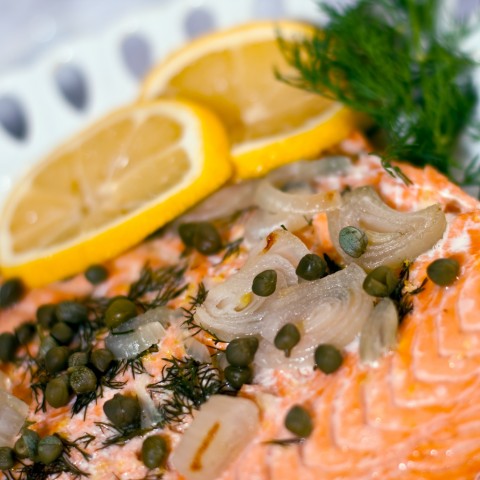
Uunilohi (“Baked salmon”)
1. Must-Try Finnish Dishes
If you haven’t tried Finnish food yet, here are five traditional dishes to start with. Watch for them when visiting Finland—or try cooking them at home!
1 – Lohikeitto (Salmon Soup)
When a country is nicknamed “the land of a thousand lakes” (in fact, there are roughly 188,000 lakes in Finland!) and has a coastline, it’s no surprise that fish features heavily in the local cuisine. Salmon is considered a special treat, and lohikeitto (“salmon soup”) is a traditional way to enjoy it. Cooked with potatoes, cream, and fresh dill, this soup makes for a hearty and comforting meal. If you’re a fan of salmon, keep your eyes peeled for savulohi (“smoked salmon”) and graavilohi (“gravlax”), too.
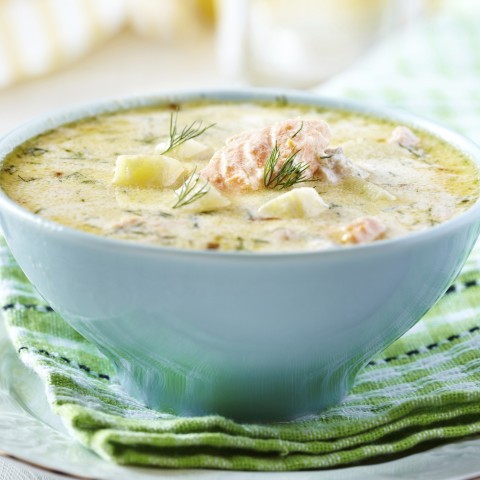
Lohikeitto (“Salmon soup”)
2 – Karjalanpaisti (Karelian Hot Pot)
Here’s a dish that will stick to your ribs! Karjalanpaisti (“Karelian hot pot”) is a traditional meat stew from Karelia that takes a long time to cook (ideally several hours), but the result is worth waiting for. Very simple but highly enjoyable, this stew is typically prepared with beef, pork, onions, and root vegetables, and seasoned with peppercorns.
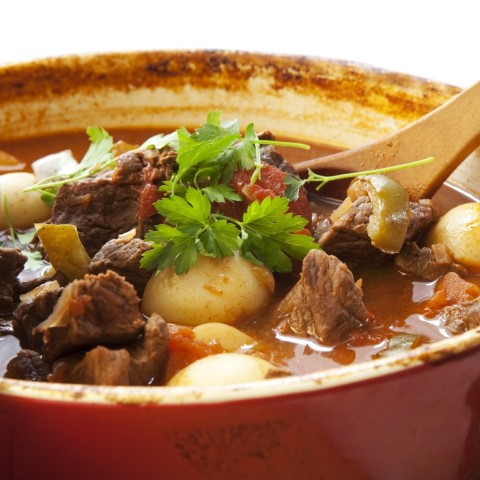
Karjalanpaisti (“Karelian hot pot”)
3 – Kalakukko (Fish Pie)
Somewhat confusingly, kalakukko literally means “fish rooster,” though no birds of any sort are involved in the preparation of this traditional Savonian dish! It’s possible that the moniker is derived from the word kukkaro (“purse”) rather than kukko (“rooster”).
To make kalakukko, rye flour dough is stuffed with either muikku (“vendace”) or ahven (“European perch”) and pork, and then baked for several hours. To make your meal even more authentic, be sure to enjoy it with a glass of piimä (“buttermilk”).

Kalakukko (“Fish pie”) (Photo by Rst2000, under CC BY-SA 3.0)
4 – Poronkäristys (Sautéed Reindeer)
Fancy sampling some traditional fare from the Finnish Lapland? Then you need to try poronkäristys (“sautéed reindeer”), a no-frills dish of thinly sliced reindeer meat seasoned with salt and pepper. For the complete experience, serve the dish with mashed potatoes and lingonberries.
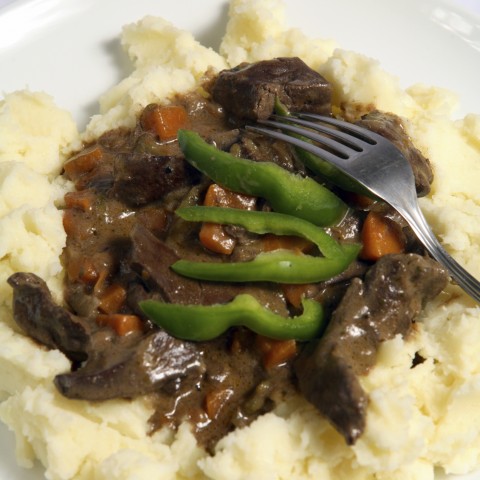
Poronkäristys (“Sautéed reindeer”)
5 – Kaalilaatikko (Cabbage Casserole)
We can’t talk about traditional Finnish foods without mentioning casseroles.
Finns are very fond of hearty oven-baked casseroles, and kaalilaatikko (“cabbage casserole”) is a perfect example. Cabbage is combined with rice (or pearl barley) and ground meat, sweetened slightly with syrup or molasses, and finally baked to tender perfection and served with lingonberries.
Other casserole dishes that are very popular in Finland include makaronilaatikko (“macaroni casserole”), perunalaatikko (“potato casserole”), lanttulaatikko (“rutabaga casserole” or “Swede casserole”), and porkkanalaatikko (“carrot casserole”), to mention but a few!

Kaalilaatikko (“Cabbage casserole”)
- Check out our free vocabulary list on FinnishPod101.com to learn how to pronounce the names of all your favorite Finnish foods!
2. Unusual Finnish Food Products
There are many wonderful Finnish flavors to discover besides the traditional recipes mentioned above. Next, we’ll be exploring some unique food products you can find in Finland. But be warned: some of them are not for the faint of heart!
1 – Salmiakki (Salmiac Liquorice)
‘Salty’ is not a quality that most people look for in their sweets, but in Finland salmiakki (a type of salty liquorice flavored with sal ammoniac) is extremely popular. In fact, Finns young and old love the stuff so much that it’s more or less considered a part of the Finnish national identity. Salmiakki is available in a vast number of different shapes and is also used to flavor other products, including chewing gum, ice cream, chocolate, biscuits, and alcoholic beverages.
And if you’ve already tried salmiakki and are ready for something even stranger, look for sweets and other products flavored with terva (“tar”)!

Salmiakki (“Salmiac liquorice”) (Photo by Tiia Monto, under CC BY-SA 4.0)
2 – Ruisleipä (Rye Bread)
Many different types of bread are eaten in Finland, but none are nearly as popular as ruisleipä (“rye bread”). Alongside salmiakki, proper rye bread is what Finns living abroad are most likely to miss from home.
Finnish rye bread is dark and sour and not to be mistaken for the sweeter, moister German-style rye bread. It’s available in many shapes and textures, such as the rounded limppu (“loaf”), flat reikäleipä (literally “hole bread”), rectangular ruispalat (literally “rye pieces”), and crunchy näkkileipä (“crispbread”).

Different types of Finnish rye bread (Photo by Hellahulla, under CC BY-SA 3.0).
3 – Karjalanpiirakka (Karelian Pasty)
Karjalanpiirakka (“Karelian pasty”) is a distinctly shaped savory pie from the region of Karelia. A typical Karelian pasty today consists of a rye crust filled with rice, though you may also come across versions filled with potato, barley, or millet, for example. The traditional accompaniment to karjalanpiirakka is munavoi (“egg butter”), which is exactly what it sounds like: boiled egg mixed with butter.
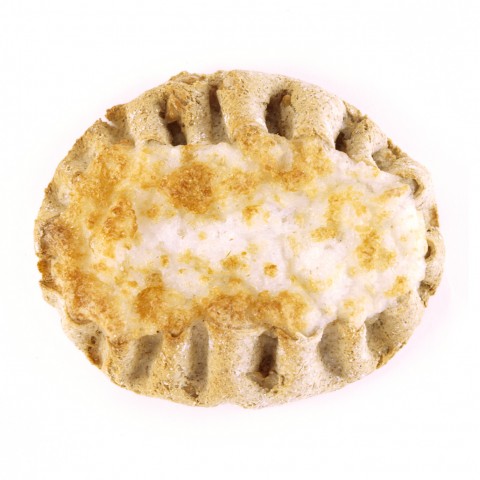
Karjalanpiirakka (“Karelian pasty”)
4 – Korvapuusti (Cinnamon Roll)
Here’s another linguistic—and culinary—delight. Korvapuusti is a popular variety of a sweet cinnamon roll filled with spiced butter, but the word can also be translated as “an ear slap.” So if someone offers you one, make sure it’s baked goods they’re talking about!
So what sets korvapuusti apart from other types of cinnamon rolls eaten in Finland and further afield? It’s the peculiar shape that is achieved by cutting diagonally through the rolled-up dough and pressing down the middle of each piece. If you fancy trying one in Finland, you’ll find them in pretty much every café. Or you can try making them at home:

Korvapuusti (“Cinnamon roll”) (Photo by Neurovelho, under CC BY-SA 3.0)
5 – Leipäjuusto (Bread Cheese)
Leipäjuusto (“bread cheese”) is a mild-flavored cheese made from cow’s milk. It looks like a rounded flat disk with black spots and is sometimes also called narskujuusto (“squeaky cheese”) due to its texture. There are many ways to enjoy bread cheese. For example, fried and topped with cloudberries or dunked in coffee!

Leipäjuusto (“Bread cheese”) (Photo by Teemu Rajala, under CC BY-SA 3.0)
6 – Viili (Finnish Curd Milk)
Viili (“curd milk”) is a thick, viscous type of yogurt cultured with lactic acid bacteria. A mold called Geotrichum candidum grows on it too, giving the product a velvety surface. Viili has a very fresh and pleasant taste, and it makes for a great breakfast when sprinkled with some fresh fruit or berries—that is, if you can get over the slimy texture!
7 – Vispipuuro (Whipped Porridge)
Vispipuuro (“whipped porridge”) is a light Finnish berry dessert made from wheat semolina and lingonberries (though other berries can be used) which give it its pink color. The porridge is whipped vigorously to create an airy texture. It’s typically eaten cold with a splash of milk.

Vispipuuro (“Whipped porridge”) (Photo by Minanla, under CC BY-SA 4.0)
8 – Mämmi (Finnish Rye Pudding)
Mämmi is a traditional Finnish Easter dessert made from rye flour and eaten chilled. It’s sweetened either naturally through a very slow cooking process, or—as is often the case with commercially produced mämmi—with dark molasses. Famously, mämmi is a bit like Marmite: you either love it or hate it, and you’ll find Finns in both camps!
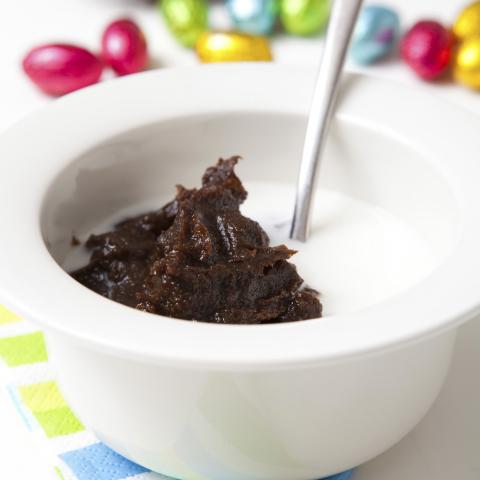
Mämmi, a Finnish Easter dessert.
3. Food Vocabulary
Now that you’re good and hungry for some traditional Finnish cuisine, it’s time to go over key Finnish food vocabulary!
1 – Talking About Food
- Minulla on nälkä. (“I’m hungry.”)
- Olen kylläinen. (“I’m full.”)
- Pidän juustosta. (“I like cheese.”)
- En pidä sienistä. (“I don’t like mushrooms.”)
- En syö punaista lihaa. (“I don’t eat red meat.”)
- Olen allerginen pähkinöille. (“I’m allergic to nuts.”)
- Lempiruokani on lohikeitto. (“My favorite dish is salmon soup.”)
2 – All About Cooking
Basic Ingredients
- Suola (“Salt”)
- Pippuri (“Pepper”)
- Sokeri (“Sugar”)
- Vesi (“Water”)
- Maito (“Milk”)
- Öljy (“Oil”)
- (Kanan)muna (“Egg”)
- Jauho (“Flour”)
- Hedelmä (“Fruit”)
- Marja (“Berry”)
- Vihannes (“Vegetable”)
- Liha (“Meat”)
- Kala (“Fish”)
- Sieni (“Mushroom”)
- Pähkinä (“Nut”)
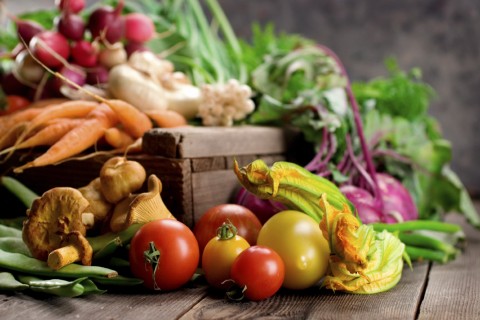
Mushrooms and vegetables.
Find more Finnish words related to ingredients on our free fruits and vegetables vocabulary list!
Utensils
- Kattila (“Saucepan”)
- Paistinpannu (“Frying pan”)
- Uuni (“An oven”)
- Veitsi (“A knife”)
- Leikkuulauta (“A cutting board”)
To learn the Finnish words for cutlery and more, turn to our food utensils and tableware vocabulary list.
Cooking verbs
- Laittaa ruokaa (“To cook”)
- Keittää (“To boil”)
- Hauduttaa (“To stew”)
- Paistaa (“To fry”)
- Uppopaistaa (“To deep-fry”)
- Paloitella (“To cut into pieces”)
- Viipaloida (“To slice”)
- Kuoria (“To peel”)
- Raastaa (“To grate”)
Turn to our list of cooking words to further expand your Finnish vocabulary.
3 – Ordering in a Restaurant
- Ruokalista (“The menu”)
- Pöytä kahdelle. (“A table for two.”)
- Alkupala (“A starter”)
- Pääruoka (“A main course”)
- Jälkiruoka (“A dessert”)
- Tarjoilija (“Waiter”)
- Lasku (“The bill”)
- Tippi (“Tip”)
Learn how to pronounce jälkiruoka and other Finnish restaurant vocabulary and phrases on FinnishPod101.com.
4. Lopuksi
In this guide, we explored the world of Finnish flavors, from traditional recipes to unusual delicacies. We also covered some essential food-related vocabulary.
Have you already tried any of the dishes on our list? Have you had a chance to talk about food with a Finn? Let us know how you got on in the comments below!
Visit FinnishPod101.com for more vocabulary lists with audio recordings and other free resources, or sign up for a Premium PLUS account for effective one-on-one learning and personalized learning content.
Until next time, happy eating!










